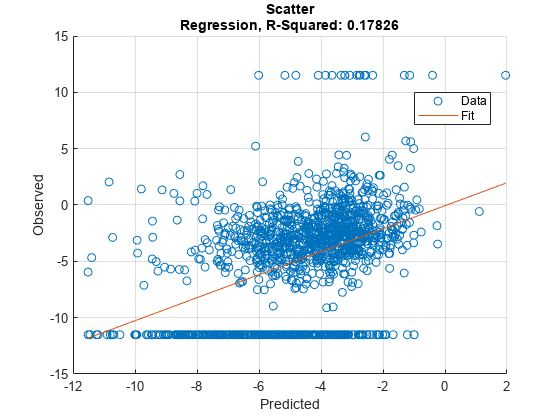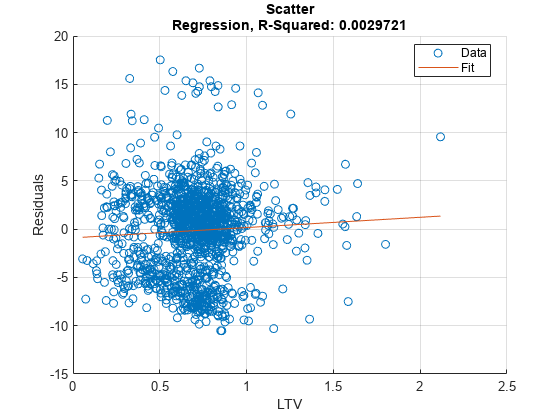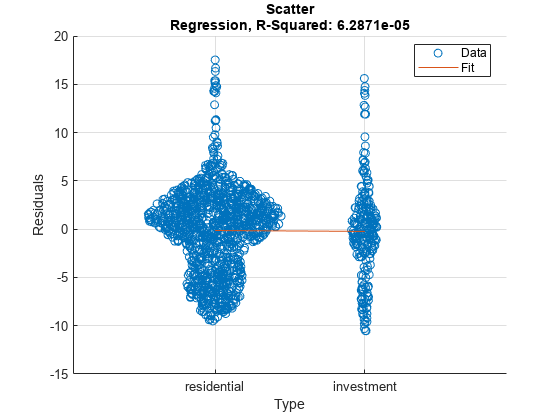modelCalibrationPlot
Syntax
Description
modelCalibrationPlot(___,
specifies options using one or more name-value pair arguments in addition to the
input arguments in the previous syntax. You can use the
Name,Value)ModelLevel name-value pair argument to compute metrics
using the underlying model's transformed scale.
h = modelCalibrationPlot(ax,___,Name,Value)h.
Examples
This example shows how to use fitLGDModel to fit data with a Regression model and then use modelCalibrationPlot to generate a scatter plot for predicted and observed LGDs.
Load Data
Load the loss given default data.
load LGDData.mat
head(data) LTV Age Type LGD
_______ _______ ___________ _________
0.89101 0.39716 residential 0.032659
0.70176 2.0939 residential 0.43564
0.72078 2.7948 residential 0.0064766
0.37013 1.237 residential 0.007947
0.36492 2.5818 residential 0
0.796 1.5957 residential 0.14572
0.60203 1.1599 residential 0.025688
0.92005 0.50253 investment 0.063182
Partition Data
Separate the data into training and test partitions.
rng('default'); % for reproducibility NumObs = height(data); c = cvpartition(NumObs,'HoldOut',0.4); TrainingInd = training(c); TestInd = test(c);
Create Regression LGD Model
Use fitLGDModel to create a Regression model using training data.
lgdModel = fitLGDModel(data(TrainingInd,:),'regression');
disp(lgdModel) Regression with properties:
ResponseTransform: "logit"
BoundaryTolerance: 1.0000e-05
ModelID: "Regression"
Description: ""
UnderlyingModel: [1×1 classreg.regr.CompactLinearModel]
PredictorVars: ["LTV" "Age" "Type"]
ResponseVar: "LGD"
WeightsVar: ""
Display the underlying model.
lgdModel.UnderlyingModel
ans =
Compact linear regression model:
LGD_logit ~ 1 + LTV + Age + Type
Estimated Coefficients:
Estimate SE tStat pValue
________ ________ _______ __________
(Intercept) -4.7549 0.36041 -13.193 3.0997e-38
LTV 2.8565 0.41777 6.8377 1.0531e-11
Age -1.5397 0.085716 -17.963 3.3172e-67
Type_investment 1.4358 0.2475 5.8012 7.587e-09
Number of observations: 2093, Error degrees of freedom: 2089
Root Mean Squared Error: 4.24
R-squared: 0.206, Adjusted R-Squared: 0.205
F-statistic vs. constant model: 181, p-value = 2.42e-104
Generate Scatter Plot of Predicted and Observed LGDs
Use modelCalibrationPlot to generate a scatter plot of predicted and observed LGDs for the test data set. The ModelLevel name-value pair argument modifies the output only for Regression models, not Tobit models, because there are no response transformations for the Tobit model.
modelCalibrationPlot(lgdModel,data(TestInd,:),ModelLevel="underlying")
This example shows how to use fitLGDModel to fit data with a Tobit model and then use modelCalibrationPlot to generate a scatter plot of predicted and observed LGDs.
Load Data
Load the loss given default data.
load LGDData.mat
head(data) LTV Age Type LGD
_______ _______ ___________ _________
0.89101 0.39716 residential 0.032659
0.70176 2.0939 residential 0.43564
0.72078 2.7948 residential 0.0064766
0.37013 1.237 residential 0.007947
0.36492 2.5818 residential 0
0.796 1.5957 residential 0.14572
0.60203 1.1599 residential 0.025688
0.92005 0.50253 investment 0.063182
Partition Data
Separate the data into training and test partitions.
rng('default'); % for reproducibility NumObs = height(data); c = cvpartition(NumObs,'HoldOut',0.4); TrainingInd = training(c); TestInd = test(c);
Create Tobit LGD Model
Use fitLGDModel to create a Tobit model using training data.
lgdModel = fitLGDModel(data(TrainingInd,:),'tobit');
disp(lgdModel) Tobit with properties:
CensoringSide: "both"
LeftLimit: 0
RightLimit: 1
Weights: [0×1 double]
ModelID: "Tobit"
Description: ""
UnderlyingModel: [1×1 risk.internal.credit.TobitModel]
PredictorVars: ["LTV" "Age" "Type"]
ResponseVar: "LGD"
WeightsVar: ""
Display the underlying model.
disp(lgdModel.UnderlyingModel)
Tobit regression model:
LGD = max(0,min(Y*,1))
Y* ~ 1 + LTV + Age + Type
Estimated coefficients:
Estimate SE tStat pValue
_________ _________ _______ __________
(Intercept) 0.058257 0.02728 2.1355 0.032837
LTV 0.20126 0.031373 6.415 1.7363e-10
Age -0.095407 0.007258 -13.145 0
Type_investment 0.10208 0.018076 5.6472 1.853e-08
(Sigma) 0.29288 0.0057084 51.307 0
Number of observations: 2093
Number of left-censored observations: 547
Number of uncensored observations: 1521
Number of right-censored observations: 25
Log-likelihood: -698.383
Generate Scatter Plot of Predicted and Observed LGDs
Use modelCalibrationPlot to generate a scatter plot of predicted and observed LGDs for the test data set.
modelCalibrationPlot(lgdModel,data(TestInd,:))

This example shows how to use fitLGDModel to fit data with a Beta model and then use modelCalibrationPlot to generate a scatter plot of predicted and observed LGDs.
Load Data
Load the loss given default data.
load LGDData.mat
head(data) LTV Age Type LGD
_______ _______ ___________ _________
0.89101 0.39716 residential 0.032659
0.70176 2.0939 residential 0.43564
0.72078 2.7948 residential 0.0064766
0.37013 1.237 residential 0.007947
0.36492 2.5818 residential 0
0.796 1.5957 residential 0.14572
0.60203 1.1599 residential 0.025688
0.92005 0.50253 investment 0.063182
Partition Data
Separate the data into training and test partitions.
rng('default'); % for reproducibility NumObs = height(data); c = cvpartition(NumObs,'HoldOut',0.4); TrainingInd = training(c); TestInd = test(c);
Create Beta LGD Model
Use fitLGDModel to create a Beta model using training data.
lgdModel = fitLGDModel(data(TrainingInd,:),'Beta');
disp(lgdModel) Beta with properties:
BoundaryTolerance: 1.0000e-05
ModelID: "Beta"
Description: ""
UnderlyingModel: [1×1 risk.internal.credit.BetaModel]
PredictorVars: ["LTV" "Age" "Type"]
ResponseVar: "LGD"
WeightsVar: ""
Display the underlying model.
disp(lgdModel.UnderlyingModel)
Beta regression model:
logit(LGD) ~ 1_mu + LTV_mu + Age_mu + Type_mu
log(LGD) ~ 1_phi + LTV_phi + Age_phi + Type_phi
Estimated coefficients:
Estimate SE tStat pValue
________ ________ _______ __________
(Intercept)_mu -1.3772 0.13201 -10.433 0
LTV_mu 0.6027 0.15087 3.9948 6.6993e-05
Age_mu -0.47464 0.040264 -11.788 0
Type_investment_mu 0.45372 0.085143 5.3289 1.0941e-07
(Intercept)_phi -0.16336 0.12591 -1.2974 0.19462
LTV_phi 0.055886 0.14719 0.37969 0.70421
Age_phi 0.22887 0.040335 5.6743 1.586e-08
Type_investment_phi -0.14102 0.078155 -1.8044 0.071313
Number of observations: 2093
Log-likelihood: -5291.04
Generate Scatter Plot of Predicted and Observed LGDs
Use modelCalibrationPlot to generate a scatter plot of predicted and observed LGDs for the test data set.
modelCalibrationPlot(lgdModel,data(TestInd,:))

modelCalibrationPlot generates a scatter plot of observed vs. predicted LGD values. The 'XData' and 'YData' name-value arguments allow you to visualize the residuals or generate a scatter plot against a variable of interest.
Load Data
Load the loss given default data.
load LGDData.mat
head(data) LTV Age Type LGD
_______ _______ ___________ _________
0.89101 0.39716 residential 0.032659
0.70176 2.0939 residential 0.43564
0.72078 2.7948 residential 0.0064766
0.37013 1.237 residential 0.007947
0.36492 2.5818 residential 0
0.796 1.5957 residential 0.14572
0.60203 1.1599 residential 0.025688
0.92005 0.50253 investment 0.063182
Partition Data
Separate the data into training and test partitions.
rng('default'); % for reproducibility NumObs = height(data); c = cvpartition(NumObs,'HoldOut',0.4); TrainingInd = training(c); TestInd = test(c);
Create Regression LGD Model
Use fitLGDModel to create a Regression model using training data.
lgdModel = fitLGDModel(data(TrainingInd,:),'regression');
disp(lgdModel) Regression with properties:
ResponseTransform: "logit"
BoundaryTolerance: 1.0000e-05
ModelID: "Regression"
Description: ""
UnderlyingModel: [1×1 classreg.regr.CompactLinearModel]
PredictorVars: ["LTV" "Age" "Type"]
ResponseVar: "LGD"
WeightsVar: ""
Display the underlying model.
disp(lgdModel.UnderlyingModel)
Compact linear regression model:
LGD_logit ~ 1 + LTV + Age + Type
Estimated Coefficients:
Estimate SE tStat pValue
________ ________ _______ __________
(Intercept) -4.7549 0.36041 -13.193 3.0997e-38
LTV 2.8565 0.41777 6.8377 1.0531e-11
Age -1.5397 0.085716 -17.963 3.3172e-67
Type_investment 1.4358 0.2475 5.8012 7.587e-09
Number of observations: 2093, Error degrees of freedom: 2089
Root Mean Squared Error: 4.24
R-squared: 0.206, Adjusted R-Squared: 0.205
F-statistic vs. constant model: 181, p-value = 2.42e-104
Generate Scatter Plot of Predicted and Observed LGDs
Use modelCalibrationPlot to generate a scatter plot of residuals against LTV values.
modelCalibrationPlot(lgdModel,data(TestInd,:),XData='LTV',YData='residuals')

For Regression models, the 'ModelLevel' name-value argument allows you to visualize the plot using the underlying model scale.
modelCalibrationPlot(lgdModel,data(TestInd,:),XData='LTV',YData='residuals',ModelLevel='underlying')

For categorical variables, modelCalibrationPlot uses a swarm chart. For more information, see swarmchart.
modelCalibrationPlot(lgdModel,data(TestInd,:),XData='Type',YData='residuals',ModelLevel='underlying')

Input Arguments
Loss given default model, specified as a previously created Regression,
Tobit, or Beta object using
fitLGDModel.
Data Types: object
Data, specified as a
NumRows-by-NumCols table with
predictor and response values. The variable names and data types must be
consistent with the underlying model.
Data Types: table
(Optional) Valid axis object, specified as an ax object
that is created using axes. The plot will be
created in the axes specified by the optional ax argument
instead of in the current axes (gca). The optional argument
ax must precede any of the input argument
combinations.
Data Types: object
Name-Value Arguments
Specify optional pairs of arguments as
Name1=Value1,...,NameN=ValueN, where Name is
the argument name and Value is the corresponding value.
Name-value arguments must appear after other arguments, but the order of the
pairs does not matter.
Example: modelCalibrationPlot(lgdModel,data(TestInd,:),DataID='Testing',YData=residuals,XData='LTV')
Data set identifier, specified as DataID and a
character vector or string. The DataID is included in
the output for reporting purposes.
Data Types: char | string
Model level, specified as ModelLevel and a
character vector or string.
'top'— The accuracy metrics are computed in the LGD scale at the top model level.'underlying'— For aRegressionmodel only, the metrics are computed in the underlying model's transformed scale. The metrics are computed on the transformed LGD data.
Data Types: char | string
Identifier for the reference model, specified as
ReferenceID and a character vector or string.
'ReferenceID' is used in the scatter plot output
for reporting purposes.
Data Types: char | string
Data to plot on x-axis, specified as XData and a
character vector or string for one of the following:
'predicted'— Plot the predicted LGD values in the x-axis.'observed'— Plot the observed LGD values in the x-axis.'residuals'— Plot the residuals in the x-axis.VariableName — Use the name of the variable in the
datainput, not necessarily a model variable, to plot in the x-axis.
Data Types: char | string
Data to plot on y-axis, specified as YData and a
character vector or string for one of the following:
'predicted'— Plot the predicted LGD values in the y-axis.'observed'— Plot the observed LGD values in the y-axis.'residuals'— Plot the residuals in the y-axis.
Data Types: char | string
Output Arguments
Figure handle for the scatter and line objects, returned as handle object.
More About
The modelCalibrationPlot function returns a
scatter plot of observed vs. predicted loss given default (LGD) data with a linear
fit and reports the R-square of the linear fit.
The XData name-value pair argument allows you to change the
x values on the plot. By default, predicted LGD values are
plotted in the x-axis, but predicted LGD values, residuals, or
any variable in the data input, not necessarily a model
variable, can be used as x values. If the selected
XData is a categorical variable, a swarm chart is used. For
more information, see swarmchart.
The YData name-value pair argument allows users to change the
y values on the plot. By default, observed LGD values are
plotted in the y-axis, but predicted LGD values or residuals can
also be used as y values. YData does not
support table variables.
For Regression models, if
ModelLevel is set to 'underlying', the
LGD data is transformed into the underlying model's scale. The transformed data is
shown on the plot. The ModelLevel name-value pair argument has
no effect for Tobit models.
The linear fit and reported R-squared value always correspond to the linear regression model with the plotted y values as response and the plotted x values as the only predictor.
References
[1] Baesens, Bart, Daniel Roesch, and Harald Scheule. Credit Risk Analytics: Measurement Techniques, Applications, and Examples in SAS. Wiley, 2016.
[2] Bellini, Tiziano. IFRS 9 and CECL Credit Risk Modelling and Validation: A Practical Guide with Examples Worked in R and SAS. San Diego, CA: Elsevier, 2019.
Version History
Introduced in R2023a
See Also
Tobit | Regression | Beta | modelCalibration | modelDiscriminationPlot | modelDiscrimination | predict | fitLGDModel
MATLAB Command
You clicked a link that corresponds to this MATLAB command:
Run the command by entering it in the MATLAB Command Window. Web browsers do not support MATLAB commands.
Web サイトの選択
Web サイトを選択すると、翻訳されたコンテンツにアクセスし、地域のイベントやサービスを確認できます。現在の位置情報に基づき、次のサイトの選択を推奨します:
また、以下のリストから Web サイトを選択することもできます。
最適なサイトパフォーマンスの取得方法
中国のサイト (中国語または英語) を選択することで、最適なサイトパフォーマンスが得られます。その他の国の MathWorks のサイトは、お客様の地域からのアクセスが最適化されていません。
南北アメリカ
- América Latina (Español)
- Canada (English)
- United States (English)
ヨーロッパ
- Belgium (English)
- Denmark (English)
- Deutschland (Deutsch)
- España (Español)
- Finland (English)
- France (Français)
- Ireland (English)
- Italia (Italiano)
- Luxembourg (English)
- Netherlands (English)
- Norway (English)
- Österreich (Deutsch)
- Portugal (English)
- Sweden (English)
- Switzerland
- United Kingdom (English)